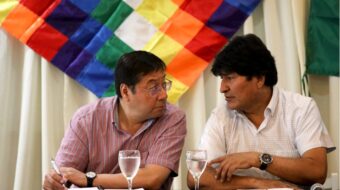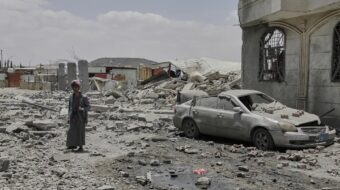‘We’re the early warning system for the rest of the world,’ says Arctic resident
When she was growing up in an Inuit community in northern Quebec, Sheila Watt-Cloutier never rode anything faster than a dog sled.
Now the 51-year-old grandmother jets across the globe speaking out on environmental issues and warning of the impending catastrophe that is global warming.
A long-time political spokesperson for the Inuit, Watt-Cloutier is actively engaged in climate change initiatives with the aim of persuading states to reduce their emissions of greenhouse gases and the use of toxins.
The very survival the Inuit is at stake, she said in a recent interview.
“We go out and hunt on the sea to put food on the table,” she said. “You go to the supermarket.”
And if there is one place on the planet where the effects of the “great warming” are immediately felt, it is in the Arctic, said Watt-Cloutier, who, as chair of the Inuit Circumpolar Conference, represents some 155,000 Inuit in Canada, the U.S., Russia and Greenland.
“We on a daily basis observe the minute changes that are occurring in the environment,” Watt-Cloutier said. “We are the guardians of the environment, in fact, because we’re on the land every day … we’re the early warning system for the rest of the world.”
Originally from Nunavik in Northern Quebec and educated in Manitoba, she now lives in Iqaluit capital of the new territory of Nunavut.
Her people are witnessing first hand the devastating affects of climate change and its relentless assault on their traditional way of life. “We’re already living this reality,” Watt-Cloutier said. “It’s not a theory in the future, it’s right now in the present.”
The ice at the polar ice cap is forming much later in the year and breaking up earlier in the spring, causing havoc for both man and animals. “The sea-ice season is a lot shorter than it used to be. And as a result we have less time to hunt on the ice. Our wildlife, the polar bear, has a lot less time so they’re become a lot thinner.”
Streams on traditional hunting routes that were once fordable have become torrents that claims lives every year. The icepacks have become so unpredictable that even seasoned hunters with knowledge of the land and the cycles, have fallen through and drowned, she said.
“What you see on the surface is no longer what it is underneath. The Arctic sink is warming from under, and the ice is changing from under as well.
“So the rules have all changed and so has the wisdom we pass on to our young people. Many of our elders are being stumped by it, because it is so unpredictable.”
The damage caused by rising temperatures is evident all around the north, although not all regions are affected in the same way. In the Beaufort Sea area, for example, erosion due to the rapid melting of the permafrost is hitting the beaches hard.
“They are having to move houses because they are crumbling,” Watt-Cloutier said. “In Nunavik the permafrost is melting so quickly that they are having to redo the pavement of the runways because are starting to crumble.”
The minutest change in the Arctic changes everything, every ecosystem. The changes in climate have brought a lot more insects and bugs, and new species of birds never before seen in the Arctic are appearing every year.
“I think everything is connected and meant to be where they are. It’s going to be an adaptation period for every species of animal, whether you are a bug, or a human being or a polar bear.”
Watt-Cloutier is fully involved in United Nations work and has for years been working on the treaty to eliminate the use persistent organic pollutants, or POPs.
The so-called “dirty dozen” are among the most fearsome toxic chemicals because of the threat they pose to both humans and animals because they last so long in the environment before breaking down.
“I was personally involved in a lot of that work,” she said. “That took me to different parts of the world, but it’s really paid off.”
Some 50 nations have signed on to the new treaty, making it one of the fastest ratified UN treaties on record. But the global work to get there took some 15 years, she said.
So as they turn their attention to stemming the tide of global warming, the Inuit continue to navigate the significant social and economic changes that have accompanied development of the north.
“We have gone from a nomadic society to a democratic self-governing people, proud to be Canadian.
“We have gone from the ‘snow age’ to the ‘space age’ in one generation.”
So are the Inuit, in a sense, contributing to their own demise?
“I get asked that question quite often,” Watt-Cloutier said. “Yes, we own airlines, we have skidoos, we have trucks, but the reality is our contribution to this problem is very minute.
“It’s off the radar in terms of what we are creating ourselves, whether it’s the toxins or the greenhouse gases. These things are coming from afar.”
The U.S. is by far the biggest culprit, producing 26 percent of the greenhouse gases emitted into the atmosphere, she said.
This article originally appeared at www.thegreatwarming.com and is reprinted with permission.









